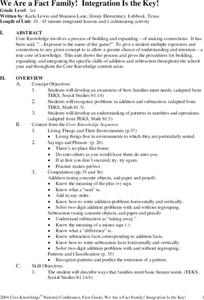Curated OER
Number Tick Tack Toe: Multicultural Awareness and Appreciation Adaptation
Students focus on this activity would be differences in ability and disability. Some of the students in the class do very well in this activity and often, or always, win in the games of Number Tick Tack Toe; other students struggle and...
Curated OER
Pick a Pet
Students construct a pictograph of favorite pets. In this pets and graphing lesson, students discuss their favorite pet and use animal magazines to find their favorite pets and cut them out. Students create a pictograph using the pictures.
Curated OER
Fun With Adhesives
Students observe, measure, and record the properties in making objects stick together using science tools. In this science lesson plan, students explore with their senses while mixing flour and water. Additionally, students share their...
Curated OER
Counting Chart
Elementary learners discover counting through a counting chart. In this math lesson, students identify numbers 1-100. They then point or recite their counting numbers.
Curated OER
Introduction to Magnetism and Electronics
Students are introduced to the concepts of magnetism and electronics. As a class, they walk through the steps of the scientific method and define new vocabulary. In groups, they are given a bag of objects and they are to separate them...
Curated OER
Make Your Own Recycled Paper
Paper Lesson Plan - Students discover how paper is made. Working together, they make their own paper. This activity introduces students to recycling; what it is and its importance. Students study the process of how paper is made, and...
Curated OER
How Size Shapes Animals
Learners investigate how size affects large and small animals differently. In this animal lesson plan, students determine how size affects different animals by constructing their own animal out of marshmallows. Once learners create...
Curated OER
Air Is there
Young scholars experiment to observe air and its mass. In this air lesson, students use the scientific method to complete experiments that demonstrate the properties of air. Young scholars view a video as follow-up.
Curated OER
The Weather Around Us
First graders explore weather patterns. In this weather lesson, 1st graders research the daily weather by creating a graph of the daily weather conditions. Students use the computer to access information regarding the weather forecast....
Curated OER
Jr. Chef Club Super Snacks Lesson 6
Students explore healthy snacks. In this nutrition and cooking lesson, students observe and identify food groups on USDA's MyPyramid food guide. Students discuss how fiber helps our digestive system and follow a recipe using yeast to...
Curated OER
Principles Of Flight: Wings That Spin
Students discover how flight is possible. For this physics lesson, students investigate the properties of a blimp and gyro-copter, comparing rotating wings and fixed wings of aircraft. Students create their own model aircraft...
Curated OER
A Frog's Life Story
Students investigate the lives of frogs by completing several worksheets. In this biology lesson, students discover the life cycle of a frog from tadpole to death. Students complete frog life cycle puzzle as well as create a...
Curated OER
A Shadow of Yourself
Learners measure the length of their shadows three times during the day, Students determine the differences in shadow lengths after each measurement. They discuss why the length changed from one time of day to another.
Curated OER
Look At Those Leaves!
Students observe and sort tree leaves. In this earth science lesson, students observe the attributes of real leaves and measure leaves using Unifix cubes.
Curated OER
We Are a Fact Family! Integration Is the Key!
Students practice addition and subtraction. In this fact families unit, students practice finding sums and differences for fact families. This unit includes ten lessons with science and social studies integration.
Curated OER
Maple Syrup
Students explore maple syrup. In this natural resources lesson, students identify a maple tree in their neighborhood and observe the sap. Students sample maple products and create a graph of the taste-testing results.
Curated OER
Weather Observation Journal
Students record weather for a period of one month. In this weather lesson, students observe weather for one month on a large pictograph. Students record clouds, wind, temperature and any other weather conditions they observe. Students...
Curated OER
Community Tree Contest
Students observe trees in their neighborhood. They practice tree identification and incorporate math skills to determine the winner of a 'Tree-mendous Tree' contest in which they determine which is the biggest tree.
Curated OER
Sunny Sunflowers
First graders, after assessing how plants grow in relation to light, create models of sunflowers within a game to help them remember their science lesson. In addition, their visual models serve as a demonstration of photo tropism in...
T. Smith Publishing
Mammals and Reptiles Cut and Paste
Adorable! Most children are really drawn to animals. With this worksheet, they cut out eight darling drawings of animals and then affix each to a page divided in half according to whether it is a mammal or a reptile. If you need it, an...
Curated OER
Measure It Up!
Students investigate the states that water may take. In this physical science lesson, students read the book, Water: Up, Down, and All Around and recall the states of water from the book. Students examine how water takes the shape of its...
Curated OER
Race the Track! Design Challenge
Students use the design process to investigate physical science. For this force and motion lesson, design a track to achieve a specified outcome. Students complete additional experiments with speed and distance. Students...
Curated OER
Veggie Chop and Data Analysis
First graders chop vegetables into fractions. In this fractions lesson plan, 1st graders cut vegetables, collect data about favorite vegetables and create a bar graph using the information. Students make inferences about the data...
Curated OER
Here's the Pitch
Students define pitch, measure varying amounts of water into containers, make predictions about the sounds made when striking the containers, put containers in order from highest to lowest pitch, and create their own sound patterns with...























